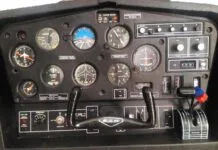Can I Get That Sim?
I am a long-time subscriber to IFR who is interested in getting more information on Ryan Koch’s DIY flight simulator shown in the lower left-hand corner of page 14 of your December 2022 issue:
1. the avionics components in this simulator (appears to have dual Garmin G5s, a Garmin GTN 750, a Garmin GFC 500, etc.);
2. whether this simulator can be purchased as an integrated and assembled unit which includes all required hardware and software components; and
3. the approximate cost of purchasing a fully integrated and assembled simulator unit.
Please put me in touch with someone (including possibly Mr. Koch) who can provide the foregoing information to me.
Thank you for your anticipated cooperation.
Terry Turner
Anchorage, Alaska
Note that the photo of Ryan’s sim is shown again on page 15 of this issue. To your specific questions:
Correct. The “EFIS” is two G5s, the navigator is a GTN 750, plus there’s a KX-155-like navcom, and the autopilot is a GFC 500. Note, however, that these are all software. They are just depictions on a touchscreen monitor that connect to the underlying capabilities in the flight simulation software. There is no hardware here other than the monitor itself. To get all this, Ryan used X-Plane at the core, but built the instrument panel in Air Manager and plugged in the GTN 750 from Realty XP. So, it’s a custom-built combination of software from three different vendors, integrated with a non-trivial amount of configuration effort.
To operate switches, one merely touches them on the monitor and the switch changes state. To turn a knob, one must touch the knob (like frequency) to select it, then actually turn the physical knob on the single Knobster—a hardware component tied into Air Manager.
All this software and the Knobster will likely cost under about $700.
Of course, Ryan added a physical yoke, throttle quadrant, and rudder pedals, each of which requires some, usually trivial, effort to get talking properly to X-Plane. The sky’s the limit on these components, but you can roughly assume under $1000 total for decent versions of all three of them.
No. Ryan assembled all the parts and pieces, then spent the effort getting them all to play nicely together. Some vendors do sell configured systems, but these will generally be even further from realistic in their emulation of a specific aircraft and are unlikely to come at all close to the configuration you might want.
We hasten to add, though, that if the configuration of the system doesn’t matter and that you’re not trying to match a particular aircraft—a valid choice, as we’ve discussed in the articles—then for somewhat more money that’s still in the same order of magnitude as a DIY sim, consider Gleim’s Virtual Cockpit BATD, or Redbird’s TD or TD2 certified complete BATDs on which you can log your efforts. As of the end of December, these were priced at $7500, $7999, and $8999 respectively.
To the prices above, add a capable computer at perhaps $2000 and maybe $1500 for the monitors. Then there’s your table, chair, etc.
(A note on the computer is in order. Even today’s basic computers are capable of adequately running the flight simulation software. The biggest demand, though, comes in displaying out-the-window scenery. Ryan opted for a single scenery monitor; even a good modest computer is adequate. However, if you might add more scenery monitors—perhaps for the view out the side windows—or add other possibly demanding software, you’ll quickly run out of the capabilities of even a modest system. For that you’d need at least a top video card, and such a computer system can easily top $3000-4000.)
Sorry, but it is beyond our ability to provide individual support and guidance on building a simulator. We hope that our articles and an occasional answered inquiry like this are of some help.
Is Coast Guard “Military”?
I was very surprised to see that in the November Sim Challenge article it was stated “(hey, Coast Guard is military).” This not true. The Coast Guard is under the Department of Commerce, not the Defense Department. The Coast Guard is an “armed force,” but not military.
Maurice Givens
[Location withheld from e-mail]
We agree with everything you said except that the Coast Guard is not military. We’re not sure what officially constitutes “military.” But, our research yielded this: “Even though the Coast Guard is not a part of the U.S. Department of Defense (DOD), the Coast Guard is part of the United States Armed Forces (also known as the military). Technically, the Coast Guard is both a federal law enforcement agency and military branch within the Department of Homeland Security.” Regardless of your interpretation of all this, we wish to recognize and thank all the dedicated men and women who serve in any of our armed forces.
Don’t Break That Glass
I was surprised your December 2022 article, “Unreliable Airspeed,” had no mention of breaking the VSI instrument glass as alternate static source if your aircraft is not equipped with an official alternate static source.
Also, in the event of a blocked static source resulting in lost altitude, the GPS altitude, while generally rather inaccurate, is better than nothing.
Thanks again for great content.
Jay Bunning
Central Oregon
Well, yeah. We could reply that the article was mostly about the systems and not what to do about a failure, but, um, well, we just overlooked the obvious. Of course, we’ll hasten to point out that we were dealing with EFIS and breaking the glass on the VSI, well, would only serve to significantly increase your repair costs without helping the immediate situation.
My GPS Lies To Me
I recently relocated to Dubai and fly a Phenom 300 with G3000 avionics. The G3000 has the capability to dead recon (in some cases) but unfortunately cannot do VOR/DME positioning. The plane also doesn’t have an IRS (inertial reference system).
The gpsjam.org website gives you an overview of where GPS jamming is occurring. According to the site they use ADSB out data to ground stations to measure the jamming. I have been routinely flying over Iraq (at the FAA approved altitude ranges), Turkey, and Pakistan. I routinely expect to lose GPS over Iraq and Turkey. In some cases the plane goes into DR (dead reckoning) mode and can maintain position within 13 NM over an hour. Other times you lose position altogether.
I take a handheld Sentry GPS unit with me. In some flights the handheld unit loses position for no more than a minute while the G3000 might lose position for up to 45 minutes. In other cases, they both lose position equally.
One particularly nasty encounter I had with GPS failure was GPS spoofing. This happened at OPKC (Lahore, Pakistan). As soon as I took off I got a warning “Terrain, Terrain, Pull Up.” The autopilot failed, my HSI spun wildly, and the GPS position of my plane was incorrect. I can promise you I didn’t cross into India and my airspeed was well above 97 knots for most of the flight.
Fortunately all of this happened in VMC. We were vectored back to the airport and flew a poor ILS using the backup compass—which is extraordinarily difficult to read if you are out of practice. (Except for my 80-year-old. former instructor, who isn’t!) After an hour the spoofing stopped and we had an uneventful flight.
The spoofing caused a Gulfstream to go around and another plane to return to the airport with us. Commercial carriers seemed to go about their day and just turn GPS off and rely on their IRS. But, flight tracking data from that day for the commercial flights shows similar spoofing.
GPS spoofing and jamming scenarios need to be part of standard IFR recurrent training. Simply cover the HSI and moving map in IMC and wish the pilot good luck.
Jeremy Stevenson
Dubai, United Arab Emirates
Yes, we here in the U.S. often overlook that global navigation satellite system (GNSS, a generic term) jamming is a problem not just in our country but all around the world. We should note, though, that the GPS fielded by the U.S. is but one such GNSS. Others are GLONASS (Russia), BeiDou (China), and Galileo (EU). In addition to these global systems, there are regional systems—Navigation with Indian Constellation (NavIC, India,) and Quasi-Zenith Satellite System (QZSS, Japan).
While our certified airborne navigators largely only use GPS, some portable receivers can receive more than one GNSS. This likely explains the occasional improved reliability of your portable receiver.
Jamming, of course, is simply disruption of the satellite signals. Spoofing, which is far more insidious, is broadcasting a powerful false satellite signal to override the real signal. This is designed to cause the navigator to report false, but meaningful, information. There is ongoing engineering effort with GNSS to improve resistance to jamming and to spoofing. So, annoying as this interference is, it will get better.
You make a good point about covering the HSI and moving map during recurrent training.
Finally, we’d mention that while the G3000 system might not have automatic VOR/DME or DME/DME positioning, you shouldn’t overlook that you can still navigate by VOR, the same as we all used to do 30-plus years ago.
Stay Visible
Elaine Kauh’s January article “You Can’t Rush Things” is spot on exposing a problem that every Part 91 pilot is subject to. Her tongue-in-cheek delivery effectively made the point that there are just some flights that end without incident through luck alone. It would seem that this flight from Oxford to Akron was just one incident away from potential disaster. Thanks for reminding us.
I have a plane at Cortland, New York, (N03) and I will frequently go west over the Finger Lakes. Ithaca airport (Class D) is close by and I always let them know (as if I were IFR) that I will be doing maneuvers in the area and request a squawk from them or Elmira. The controllers seem appreciative as there is a busy flight club in the area as well.
I would suggest that even if radio contact is not required, it is far safer to be as visible as possible
Freddie L Edelman
[Location withheld from e-mail]
Thanks for the kind words, and you’re absolutely right that it’s “far safer to be as visible as possible.”
We read ’em all and try to answer most e-mail, but it can take a month or more. Please be sure to include your full name and location. Contact us at IFR@BelvoirPubs.com.





